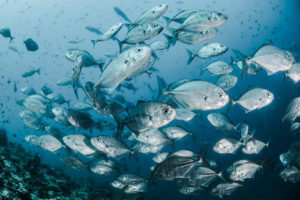Ferrous sulfate has many useful applications, all of which involve potential contact with handlers as well as the environment. As ferrous sulfate is a chemical, it is not 100% safe for people or nature and consequently requires handling with care. Here, we will discuss its toxicity to humans and the environment.
Toxicity to humans
Ferrous sulfate is fairly non-toxic, with an acute oral LD50 at 132-881 mg Fe/kg (rat) and chronic oral NOAEL 57-65 mg Fe/kg/d (rat,90 days) (1). However, it may cause skin and eye irritation. If inhaled, it may also cause headaches, nausea, and respiratory irritations. This chemical is not listed as a carcinogen by NTP, IARC, or OSHA.
The common recognized injury from ferrous sulfate is local tissue irritation. In short, the irritating action is often from hydrolysis to form sulfuric acid and may occur from ingestion, skin or eye contact, or inhalation of dust and mists. Remove victims from contaminated areas.
- Routes of Entry: Skin or eye contact, ingestion, or inhalation of dust and mists.
- SKIN / EYES: May cause corneal burns or severe irritation in eyes. Fumes or mists may cause irritation or burns to skin.
- INGESTION:Oral and gastrointestinal irritation. Local tissue damage. In addition, nausea, vomiting, diarrhea, and gastrointestinal bleeding may follow. Can be fatal if swallowed in sufficient quantities.
- INHALATION:Irritation of the respiratory system. Long term exposure may cause bronchial irritation, coughing, and bronchial pneumonia. Medical conditions generally aggravated are acute and chronic respiratory diseases.
Toxicity to the environment
Single-dose toxicity testing indicates ferrous sulfate is low in toxicity to birds. However it is moderately toxic to mammals, fish, and other aquatic organisms.
Sealife
 Ferrous sulfate is toxic to aquatic life. Precipitating and colloidal forms of the chemical may have lethal effects by clogging and causing inflammation in respiratory organs of invertebrates and fish. Furthermore, it is difficult to separate these physicochemical effects from the true eco-toxic effects even in the standard laboratory tests because lab tests are not necessarily going to be consistent with natural occurrences. Acutely toxic levels of the iron salts to aquatic organisms are observed in nominal exposure concentrations in the range equivalent to 1 – 1000 mg/l salt, with the majority of the results being in the 10 – 100 mg/l range (7).
Ferrous sulfate is toxic to aquatic life. Precipitating and colloidal forms of the chemical may have lethal effects by clogging and causing inflammation in respiratory organs of invertebrates and fish. Furthermore, it is difficult to separate these physicochemical effects from the true eco-toxic effects even in the standard laboratory tests because lab tests are not necessarily going to be consistent with natural occurrences. Acutely toxic levels of the iron salts to aquatic organisms are observed in nominal exposure concentrations in the range equivalent to 1 – 1000 mg/l salt, with the majority of the results being in the 10 – 100 mg/l range (7).
Plantlife
 Plants can, at times, be deficient in iron and ferrous sulfate can be used as a supplement to correct chlorosis (the yellowing of leaves). However, if used too often, it can be toxic to plants. One issue with using ferrous sulfate on plants is that it may burn some sensitive (usually young) plants in large enough exposures, though the damage is usually minor. (3)
Plants can, at times, be deficient in iron and ferrous sulfate can be used as a supplement to correct chlorosis (the yellowing of leaves). However, if used too often, it can be toxic to plants. One issue with using ferrous sulfate on plants is that it may burn some sensitive (usually young) plants in large enough exposures, though the damage is usually minor. (3)
Animals
 Iron toxicity most commonly occurs in dogs after accidental ingestion of the supplements or from overdoses of supplements.
Iron toxicity most commonly occurs in dogs after accidental ingestion of the supplements or from overdoses of supplements.
In brief, the forms of iron that may result in toxicity are:
- Ferrous fumarate
- Ferrous sulfate
- Ferric phosphate
- Ferrous carbonate
Toxic levels of iron cause damage to the stomach and intestinal lining. It can also cause severe liver damage and heart damage.
Dogs are more easily affected by iron overdoses than people because they do not have a way to excrete excessive iron from their bodies. If low doses of iron are given over a period of time, toxicity can still develop since their body cannot get rid of the iron already present. (4)
A study in Clinical Toxicology Journal found that ferrous sulfate also can be toxic to wildlife in high enough doses, mostly damaging their digestive tract. (5)
Accidental release of ferrous sulfate
According to its safety data sheet, these precautions should be taken for an accidental release of ferrous sulfate:
- Wear PPE appropriate for handling the material.
- No smoking or eating in spill areas.
- Absorb small spills with sand or vermiculite.
- Place contaminated material in appropriate container for disposal.
- If spilled on the ground, the affected area should be removed to a depth of 1 to 2 inches and after that placed in an appropriate container.
- Handle large spills according to a predetermined plan.
- Do not flush material to public sewer systems, or likewise, to any waterways.
- Wear appropriate protective clothing and equipment during cleanup activities.
- Ensure adequate decontamination of tools and equipment following cleanup.
- Adequate ventilation is required when neutralizing spills / leaks.
Environmentally friendly ferrous sulfate practices at Affinity Chemical
Affinity Chemical adheres to the safest handling practices to protect the environment as well as our people and customers who work with ferrous sulfate. Moreover, we produce our ferrous in a manner which minimizes pollution. Learn more about our zero-emission (aka “green”) facilities.
Need ferrous sulfate? Give us a call today!
Resources
- https://www.affinitychemical.com/content/uploads/2019/05/AffinityChemical-FerrousSDSV1.pdf
- https://flambeaumineexposed.files.wordpress.com/2012/12/cd-125-100.pdf
- https://www.echocommunity.org/en/resources/a8482fc0-639a-4964-a56c-00b752c9b588
- https://www.petplace.com/article/dogs/pet-health/iron-toxicity-in-dogs/
- https://www.tandfonline.com/doi/full/10.1081/CLT-200068842
- https://www.co.thurston.wa.us/health/ehipm/pdf_terr/terrestrial%20actives/Ferrous%20sulfate.pdf
- https://hpvchemicals.oecd.org/ui/handler.axd?id=71ff3b32-63bb-40b5-940d-d378879d209f